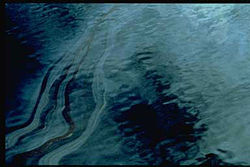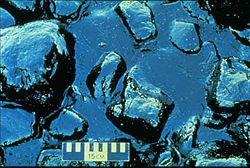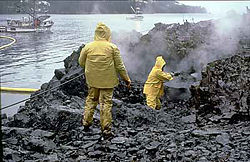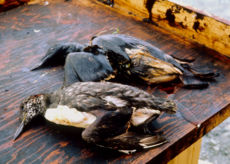Exxon Valdez oil spill
2008/9 Schools Wikipedia Selection. Related subjects: Air & Sea transport
The Exxon Valdez Oil Spill, which occurred on 24 March 1989, is considered one of the most devastating man-made environmental disasters ever to occur at sea. As significant as the Exxon Valdez spill was, it ranks well down on the list of the world's largest oil spills in terms of volume released. However, Prince William Sound's remote location (accessible only by helicopter and boat) made government and industry response efforts difficult and severely taxed existing plans for response. The region was a habitat for salmon, sea otters, seals, sea birds and the great white shark. The vessel spilled 10.8 million gallons of unrefined Alaskan crude oil into the sea.
The accident
The petroleum oil tanker Exxon Valdez departed the Valdez oil terminal, Alaska at 9:12 pm March 23, 1989 with 53 million gallons of crude oil bound for California. A harbour pilot guided the ship through the Valdez Narrows before departing the ship and returning control to Captain Joseph Hazelwood, the ship's master. The ship maneuvered out of the shipping lane to avoid icebergs. Following the maneuver and sometime after 11 pm, Hazelwood departed the wheel house and was in his stateroom at the time of the accident. He left Third Mate Gregory Cousins in charge of the wheel house and Able Seaman Robert Kagan at the helm with instructions to return to the shipping lane at a prearranged point. Exxon Valdez failed to return to the shipping lanes and struck Bligh Reef at around 12:04 am 24 March 1989. The accident resulted in the discharge of approximately 11 million gallons of oil (240,000 barrels), 20% of the cargo, into Prince William Sound.
The cause of incident was investigated by the National Transportation Safety Board who identified the four following factors as contributing to the grounding of the vessel:
- The third mate failed to properly maneuver the vessel, possibly due to fatigue and excessive workload.
- The master failed to provide navigation watch, possibly due to the impairment of alcohol.
- Exxon Shipping Company failed to supervise the master and provide a rested and sufficient crew for the Exxon Valdez.
- The U.S. Coast Guard failed to provide an effective vessel traffic system.
The Board made a number of recommendations, such as changes to the work patterns of Exxon crew in order to address the causes of the accident.
Amount spilled
According to official reports, the ship carried 53,094,510 gallons of oil, of which 10.8 million gallons were spilled into the Prince William Sound. This figure has become the consensus estimate of the spill's volume, as it has been accepted by the State of Alaska's Exxon Valdez Oil Spill Trustee Council, the National Oceanic and Atmospheric Administration, and environmental groups such as Greenpeace and the Sierra Club, among others.
Some groups, such as Defenders of Wildlife, dispute the official estimates, maintaining that the volume of the spill has been underreported because oil reclaimed from the damaged tanker would have been emulsified in seawater, throwing off calculations.
Cleanup Measures
The first cleanup response was through the use of a surfactant and solvent mixture called a dispersant. A private company applied dispersant on 24 March with a helicopter and dispersant bucket. Because there was not enough wave action to mix the dispersant with the oil in the water, the use of the dispersant was discontinued. One trial burn was also conducted during the early stages of the spill, in a region of the spill isolated from the rest by a fire-resistant boom. The test was relatively successful, but because of unfavorable weather no additional burning was attempted in this cleanup effort. Mechanical cleanup was started shortly afterwards using booms and skimmers, but the skimmers were not readily available during the first 24 hours following the spill, and thick oil and kelp tended to clog the equipment.
Exxon was widely criticized for its slow response to cleaning up the disaster and John Devens, the Mayor of Valdez, has said his community felt betrayed by Exxon's inadequate response to the crisis. Working with the U.S. Coast Guard, which officially led the response, Exxon mounted a cleanup effort that exceeded in cost, scope and thoroughness any previous oil spill cleanup. More than 11,000 Alaska residents, along with some Exxon employees, worked throughout the region to try to restore the environment.
Because Prince William Sound contained many rocky coves where the oil collected, the decision was taken to displace it with high-pressure hot water. But this also displaced and destroyed the microbial populations on the shoreline; many of these organisms (e.g. Plankton) are the basis of the coastal marine food chain, and others (e.g. certain bacteria and fungi) are capable of facilitating the biodegradation of oil. Some think the oil should have been left where it was to degrade gradually; at the time, both scientific advice and public pressure was to clean everything, but since then, a much greater understanding of natural and facilitated remediation processes has developed, due somewhat in part to the opportunity presented for study by the Exxon Valdez spill.
Exxon later released "Scientists and the Alaska Oil Spill," a video carrying the label "A Video for Students", provided to schools; this video is reputed to misrepresent the clean-up process.
Despite the extensive cleanup attempts, a study conducted by the National Oceanic and Atmospheric Administration (NOAA) of the USA determined that as of early 2007 more than 26,000 gallons of oil remain in the sandy soil of the contaminated shoreline, declining at a rate of less than 4% per year.
Environmental consequences
Both the long and short-term effects of the oil spill have been studied comprehensively. Thousands of animals died immediately; the best estimates include 250,000–500,000 seabirds, 2,800–5,000 sea otters, approximately 12 river otters, 300 harbour seals, 250 bald eagles, and 22 orcas, as well as the destruction of billions of salmon and herring eggs. Due to a thorough cleanup, little visual evidence of the event remained in areas frequented by humans just 1 year later; ExxonMobil claims in a recent statement that "The environment in Prince William Sound is healthy, robust and thriving. That's evident to anyone who's been there..." However, the effects of the spill continue to be felt today. Overall reductions in population have been seen in various ocean animals, including stunted growth in pink salmon populations. Sea otters and ducks also showed higher death rates in following years, partially because they ingested prey from contaminated soil and from ingestion of oil residues on hair due to grooming.
Almost 15 years after the spill, a team of scientists at the University of North Carolina found that the effects are lasting far longer than expected. The team estimates some shoreline habitats may take up to 30 years to recover. ExxonMobil denies any concerns over this, stating that they anticipated a remaining fraction that they assert will not cause any long-term ecological impacts, according to the conclusions of 350 peer-reviewed studies. However a study from scientists from the National Oceanic and Atmospheric Administration concluded that this contamination can produce chronic low-level exposure, discourage subsistence where the contamination is heavy, and decrease the "wilderness character" of the area.
Litigation
In 1994, in the case of Baker vs. Exxon, an Anchorage jury awarded $287 million for actual damages and $5 billion for punitive damages. The punitive damages amount was equal to a single year's profit by Exxon at that time.
Exxon appealed the ruling and the 9th U.S. Circuit Court of Appeals ordered the original judge, Russel Holland, to reduce the punitive damages. On December 6, 2002, the judge announced that he had reduced the damages to $4 billion, which he concluded was justified by the facts of the case and was not grossly excessive.
Exxon appealed again, sending the case back to court to be considered in regard to a recent Supreme Court ruling in a similar case, which caused Judge Holland to increase the punitive damages to $4.5 billion, plus interest.
After more appeals, and oral arguments heard by the 9th Circuit Appellate Court on 27 January, 2006, the damages award was cut to $2.5 billion on 22 December, 2006. The court cited recent U.S. Supreme Court rulings relative to limits on punitive damages.
Exxon appealed again. On 23 May, 2007, the Ninth U.S. Circuit Court of Appeals denied Exxon Mobil Corp.'s request for another hearing, letting stand its ruling that Exxon owes $2.5 billion in punitive damages. Exxon then appealed to the U.S. Supreme Court, which on 29 October, 2007 has agreed to decide whether Exxon Mobil Corp. should pay the $2.5 billion in punitive damages. The case will likely be heard in the spring of 2008. Justice Samuel Alito, who owns between $100,000 and $250,000 in Exxon stock, recused himself from the case .
Exxon's official position is that punitive damages greater than $25 million are not justified because the spill resulted from an accident, and because Exxon spent an estimated $2 billion cleaning up the spill, along with a further $1 billion to settle civil and criminal charges related to the case. Attorneys for the plaintiffs contended that Exxon bore responsibility for the accident because the company "put a drunk in charge of a tanker in Prince William Sound."
Exxon recovered a significant portion of clean-up and legal expenses through insurance claims and tax deductions for the loss of the Valdez. Also, in 1991, Exxon made a separate financial settlement with a group of seafood producers known as the Seattle Seven for the disaster's effect on the Alaskan seafood industry. The agreement granted $63.75 million to the Seattle Seven but stipulated that the seafood companies would have to repay almost all of any punitive damages to Exxon.
"America's largest oil company soon faced suits from the federal government and from native tribal and fishing communities. In 1994 a federal district court jury ordered Exxon to pay $5 billion in punitive damages to 30,000 natives, fishermen, and businesses suffering economic hardship because of the spill. To date, Exxon hasn't turned over a penny in satisfaction of that judgment. In fact, the company is earning $400 million a year in interest on the money reserved in case it's ultimately compelled to pay up. Lee Raymond, Exxon's CEO, has said that the jury award was an "excessive and unwarranted judgment." Exxon has instigated appeals and other legal maneuvers to squash it. Among other tactics Exxon has claimed that a court bailiff tried to influence a juror by showing him a bullet and his gun while saying that a juror who was holding out for Exxon should be "put out of her misery." The bailiff, Donald Warwick, died in 1995. Two years ago, the federal judge, H. Russel Holland, found the allegations groundless."
Ship
In the aftermath of the Exxon Valdez incident, the U.S. Congress passed the Oil Pollution Act of 1990, including a clause prohibiting vessels that had caused oil spills of more than one million U.S. gallons (3,800 m³). In April 1998, the company argued in a legal action against the U.S. government that the ship should be allowed back to Valdez, since the regulation was unfairly directed at Exxon alone (no other ships meet this criterion). The Oil Pollution Act also set a schedule for the gradual phase in of a double hull design, providing an additional layer between the oil tanks and the ocean. While a double hull would likely not have prevented the Valdez disaster, a Coast Guard study estimated that it would have cut the amount of oil spilled by 60 percent.
The Exxon Valdez supertanker was towed to San Diego, arriving on July 10 and repairs began in July 30, 1989. Approximately 1,600 tons of steel were removed and replaced. In June 1990 the tanker, renamed SeaRiver Mediterranean, left harbour after $30 million of repairs. She has since been renamed Mediterranean, and was still sailing as of August 2007. The vessel is current owned by SeaRiver Maritime, a wholly owned subsidiary of ExxonMobil.
Other consequences
The Oil, Chemical, and Atomic Workers Union, representing approximately 40,000 workers nationwide, announced opposition to drilling in the Arctic National Wildlife Refuge (ANWR) until Congress enacted a comprehensive national energy policy. In the aftermath of the spill, Alaska governor Steve Cowper issued an executive order requiring two tugboats to escort every loaded tanker from Valdez out through Prince William Sound to Hinchinbrook Entrance. As the plan evolved in the 1990s, one of the two routine tugboats was replaced with a 210 foot (64 m) Escort Response Vehicle (ERV). The majority of tankers at Valdez are still single-hulled, but Congress has enacted legislation requiring all tankers to be double-hulled by 2015.
In 1991, following the collapse of the local marine population (particularly clams, herring, and seals) the Chugach Native American group went bankrupt
Many of the real estate appraisal methods used to value contaminated property and brownfields were developed as a result of and following the Exxon Valdez Oil Spill. The use of survey research (e.g. -- contingent valuation and conjoint measurement) became a well accepted appraisal method as a result of the complex valuation problems associated with contamination
According to several studies funded by the state of Alaska, the spill had both short and long term economic effects. These included the loss of recreational sports fisheries, reduced tourism, and an estimate of what economists call " existence value," which is the value to the public of a pristine Prince William Sound.
Following the advent of WikiScanner, it came to light that someone from within Exxon Mobil had altered the descriptions of the oil spill in this article which downplayed its severity.



